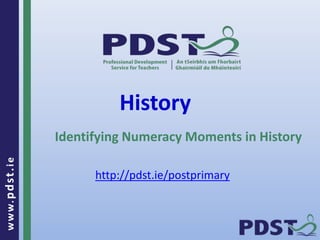
Numeracy moments in history
- 1. www.pdst . ie History Identifying Numeracy Moments in History http://pdst.ie/postprimary
- 2. www.pdst . ie What are numeracy moments?
- 4. www.pdst . ie Numeracy is NOT LIMITED to the ability to use numbers, to add, subtract, multiply and divide. Numeracy encompasses the ability to use mathematical understanding and skills to solve problems and meet the demands of day-to-day living in complex social settings. Numeracy involves being able to: • Think and communicate quantitatively • Make sense of data • Have a spatial awareness • Understand patterns and sequences • Recognise situations where mathematical reasoning can be applied to solve problems. (National Literacy & Numeracy Strategy, 2011)
- 5. www.pdst . ie Numeracy • There are opportunities to acquire numeracy skills and concepts in History. • Questioning, explanations, justifications and higher order thinking should be used and explored where appropriate. • Where numeracy arises in a natural, uncontrived manner the language, procedure, and concept should be dealt with in a manner that is consistent to that of the mathematics department.
- 6. www.pdst . ie Numeracy In history certain topics give rise to opportunities for subject teachers to reinforce common language, procedures, and concepts that students experience in mathematics lessons
- 7. www.pdst . ie Can you identify numeracy moments in the teaching of the History syllabi?
- 8. www.pdst . ie Activity Number, money, measure Data handling Shape & Space Relationships & patterns
- 9. www.pdst . ie Number, Money & Measure Data Handling • Are students encouraged to estimate, calculate and check their answers? • Are the approaches used in line with and of the same standard as those the students would use in mathematics lessons? • Where appropriate is the concept of bias discussed in lessons? • Are students encouraged to choose appropriate graphical representations? • Are students encouraged to retrieve, interpret and draw conclusions from the data presented? • Can students identify and give examples of primary and secondary data? Shape and Space Relationships & Patterns • Are students encouraged to estimate, calculate and check various measurements? • Are students encouraged to use appropriate units of measure? • Can students identify the architectural features from key periods in history? • Are students encouraged to make connections between cause and effect?
- 10. www.pdst . ie
- 11. www.pdst . ie
- 12. www.pdst . ie
- 13. www.pdst . ie Knowledge Understanding Application Analysis Creating Evaluation Count Choose Define Describe Identify Label Match Name Outline Record State Write Associate Classify Compare Demonstrate Discuss Estimate Interpret Give examples Rewrite Paraphrase Add Apply Calculate Demonstrate Divide Examine Graph Prepare Produce Show Solve Use Analyse Combine Design Develop Illustrate Investigate Observe Outline Point out Select Compile Compose Create Generate Imagine Order Organise Plan Rearrange Assess Compare Conclude Contrast Debate Interpret Measure Prove Rank Rate Blooms Taxonomy of Critical Thinking
- 14. www.pdst . ie
- 15. www.pdst . ie
- 16. www.pdst . ie http://cmsnew.pdst.ie/node/3248
- 17. www.pdst . ie Numeracy in School
- 18. Fí s Foghlaim Fo rbai r t www.pdst.ie © P D S T 2 0 1 4 This work is made available under the terms of the Creative Commons Attribution Share Alike 3.0 Licence http://creativecommons.org/licenses/by-sa/3.0/ie/. You may use and re-use this material (not including images and logos) free of charge in any format or medium, under the terms of the Creative Commons Attribution Share Alike Licence.
Notas do Editor
- Activity Participants in groups reflect on the Junior or Senior Cycle course and identify numeracy moments under the headings listed above. There is extra information on the hand-out to assist them in this activity.
- The content relates to the third year course amend this slide